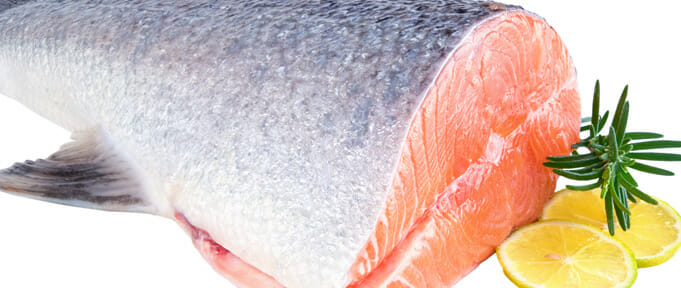Salmon, Atlantic
This is, numerically, the most important species of salmon, accounting for a quarter of the world salmon production. It is virtually all farmed, with very few wild fish (less than 3,000 tons annually) harvested. Salmon farming first emerged on a commercial scale in the early 1980s, with Norway pioneering the farming of Atlantic salmon. A decade later, production has increased 30-fold, and more than a dozen countries are involved. The food of farmed Atlantic salmon has resulted in greater salmon supply and lower prices, and it has to some extent taken the seasonality out of salmon. Until fairly recently, most farmed Atlantic salmon was destined for white table cloth restaurants, but producers are increasingly pushing retail sales and targeting mid-scale restaurants with new product forms.Product pdf for download
-
3.5 oz (100g) raw edible portion
-
Calories 187
-
Calories from Fat 70
-
Total Fat 8g/12%
-
Saturated Fat 1g/5%
-
Cholesterol 58mg/19%
-
Sodium 58mg/2%
-
Carbohydrates 0g
-
Protein 26
-
Potassium 572mg
Harvest Method
Producers of Atlantic salmon take time and care when harvesting the salmon to ensure the fish experience the least amount of stress possible. Reducing stress during harvest has shown to have benefits: brighter color and improved texture.
Weight Range
4 to 12 pounds, although they can grow to 40 pounds.
Source
Atlantic salmon is raised year-round in pens all over the world. The biggest producers are Norway and the U.K., but is also farmed in the U.S., Canada, Chile, the Shetland Islands of Scotland, and Ireland.
Appearance
To distinguish Atlantic from Pacific salmon, count the rays on the anal fin. A Pacific salmon have between 13 and 19; Atlantic’s have 10 or less. Also, Atlantic’s have a smaller head in relation to its body than that of the Pacific variety. Atlantic salmon is easily confused with steelhead; however, Atlantic salmon does not have spots below the lateral line.
Characteristics
Atlantic salmon have pink to red flesh and meat that is moist, oily, and delicately flavored, but will vary depending on growing conditions. Atlantic salmon have silver skins and small black spots on the back and sides above the lateral line.
Aroma
There should be no rancid, sour, or abnormal odors.
Preparation Caution
While the incident of parasites may be lower in farmed salmon that its wild equivalent, it is still smart to take precautions when cooking this species. Cook salmon until it reaches an internal temperature of 140°F or freeze rapidly or for prolonged periods before consumption.
Quality Control
Meat should be free from processing debris such as skin and bones. Look for loose scales (on non-skinned salmon) as well as blood clots and belly burn and cuts on the belly wall.
Dehydration
There should be no loss of moisture from surface tissue, which can result in dry, porous, or spongy condition.
Handling/Storage
Atlantic salmon needs to be chilled. The fish, when frozen, should be kept at a temperature of -20°F. When refrigerated, it should be stored at 34°F.
Chemical Additives
Antibiotic drugs are approved for use in salmon farming. These drugs are chemicals meant to kill sea lice. Shrimp and krill, which contain carotenoids, are salmon’s natural food and are added to salmon feed to make the flesh redder. Growth hormones are not used in salmon farming.
Market Segment
Atlantic salmon is appropriate in the casual dining, fine dining, hotel, and resort/club segments of the market.
